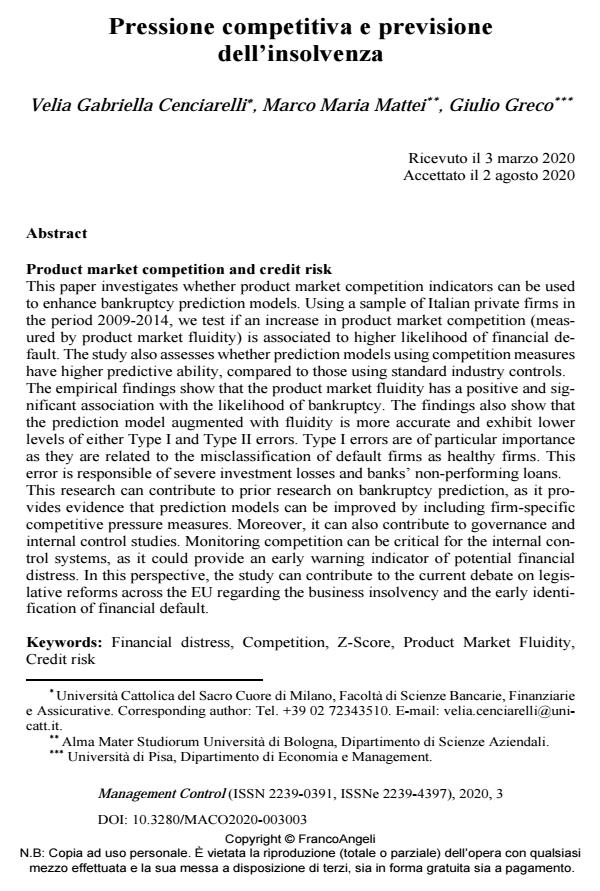Product market competition and credit risk
Journal title MANAGEMENT CONTROL
Author/s Velia Gabriella Cenciarelli, Marco Maria Mattei, Giulio Greco
Publishing Year 2020 Issue 2020/3
Language Italian Pages 24 P. 35-58 File size 310 KB
DOI 10.3280/MACO2020-003003
DOI is like a bar code for intellectual property: to have more infomation
click here
Below, you can see the article first page
If you want to buy this article in PDF format, you can do it, following the instructions to buy download credits

FrancoAngeli is member of Publishers International Linking Association, Inc (PILA), a not-for-profit association which run the CrossRef service enabling links to and from online scholarly content.
This paper investigates whether product market competition indicators can be used to enhance bankruptcy prediction models. Using a sample of Italian private firms in the period 2009-2014, we test if an increase in product market competi-tion (measured by product market fluidity) is associated to higher likelihood of fi-nancial default. The study also assesses whether prediction models using competi-tion measures have higher predictive ability, compared to those using standard in-dustry controls. The empirical findings show that the product market fluidity has a positive and significant association with the likelihood of bankruptcy. The findings also show that the prediction model augmented with fluidity is more accurate and exhibit lower levels of either Type I and Type II errors. Type I errors are of particular im-portance as they are related to the misclassification of default firms as healthy firms. This error is responsible of severe investment losses and banks’ non-performing loans. This research can contribute to prior research on bankruptcy prediction, as it pro-vides evidence that prediction models can be improved by including firm-specific competitive pressure measures. Moreover, it can also contribute to governance and internal control studies. Monitoring competition can be critical for the internal control systems, as it could provide an early warning indicator of potential finan-cial distress. In this perspective, the study can contribute to the current debate on legislative reforms across the EU regarding the business insolvency and the early identification of financial default.
Keywords: Financial distress, Competition, Z-Score, Product Market Fluidity, Credit risk
- The relevance of cash flow information in predicting corporate bankruptcy in Italian private companies Simone Poli, Marco Gatti, in MANAGEMENT CONTROL 1/2024 pp.179
DOI: 10.3280/MACO2024-001009 - Le performance dei modelli di credit scoring in contesti di forte instabilità macroeconomica: il ruolo delle Reti Neurali Artificiali Enrico Supino, Nicola Piras, in MANAGEMENT CONTROL 2/2022 pp.41
DOI: 10.3280/MACO2022-002003 - I modelli predittivi della crisi e dell'insolvenza aziendale. Una systematic review Luca Ianni, Gianluca Marullo, Stefania Migliori, Francesco De Luca, in MANAGEMENT CONTROL 2/2021 pp.127
DOI: 10.3280/MACO2021-002007
Velia Gabriella Cenciarelli, Marco Maria Mattei, Giulio Greco, Pressione competitiva e previsione dell’insolvenza in "MANAGEMENT CONTROL" 3/2020, pp 35-58, DOI: 10.3280/MACO2020-003003